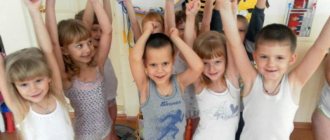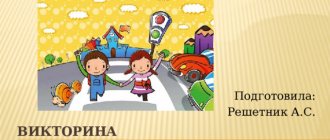Complexes of general developmental exercises for older children
Ekaterina Alekyan
Complexes of general developmental exercises for older children
Complexes of general developmental exercises for older children
Morning exercises
June 1 week
1. "On the toe"
I. p.: feet shoulder-width apart, arms down. 1-head tilt to the right (left, right (left)
foot to the side on the toe, raise your right
(left)
hand to the side; 2nd. p.Pov: 6-8 times.
2. Side bends
I. p.: the same, hands to shoulders. 1-tilt to the right (left, 2nd p., 3-tilt to the right (left)
with hand, 4th. p. Rep. 4-6 times.
3. Bends down
I. p.: the same. 1- bend forward, arms to the sides, 2-i. n., 3-tilt down, reach the floor, 4-i. p.Pov: 4-6 times.
4. "We play with our toes"
I. p.: sitting on the floor, legs together, hands resting behind. Alternately raise and lower your toes.
5. "Scissors"
I. p.: lying on your elbows. Straight leg cross movements.
6. "Boat"
I. p.: lying on your stomach, arms straight. 1-raise your straight arms and legs up, bend your back, 2-i. p.Pov: 6-8 times.
7. Turns
I. p.: standing, feet shoulder-width apart, hands to shoulders. 1-turn right (left, right (left)
move your hand back, look at your palm, 2nd. p.Pov: 6-8 times.
8. Jumping
I. p.: one leg in front, the other behind, hands on the belt. Swap your legs while jumping. Alternate with breathing exercises or walking .
June 2 week
1. "Scissors in Motion"
I. p.: standing, feet shoulder-width apart, arms straight in front of you. Cross movements of the hands in front of you up and down.
2. Side bends
I. p.: the same, hands behind the head. 1-tilt to the right (left, 2nd p.Pov: 6-8 times.
3. Lunges
I. p.: o. s., hands on the belt. Place your straight leg back on your toes as far as possible, bend the other leg. Do a few springy squats. Change legs.
4. "The sock is jumping"
I. p.: sitting on the floor, hands resting behind. Bend one leg, with a sharp toe touching the floor on one side of the other leg, on the other. Same with the other leg.
6. "Sit down"
I. p.: lying on your back, boys hands behind their heads, girls straight. 1-sit, 2i. p.Pov: 6-7 times.
7. "Ring"
I. p.: lying on your stomach, arms resting in front of your chest. Straighten your arms, lower your head back, try to touch your toes to your head.
8. Jumping
I. p.: legs together. When jumping, move your legs to one side and the other. Alternate with breathing exercises or walking .
June 3 week
1. "Behind your back"
I. p.: standing, feet shoulder-width apart, hoop grip from the sides below. 1- raise the hoop up, 2- lower it by the shoulders, 3,4- and. p.Pov: 6-7 times.
2. Side bends
I. p.: standing, feet shoulder-width apart, hoop below. 1- lift the hoop horizontally up, 2- tilt to the right (left, 3.4- etc. P.R.: 6-8 times.
3. Bends down
I. p.: standing, feet shoulder-width apart, hoop on the floor behind the feet, hands on the belt. 1- tilt down, reach the hoop, 2- and. p.Pov: 6-7 times.
4. Squats
I. p.: standing, heels together, toes apart, hoop below. 1- sit down, keep your back straight, spread your knees, bring the hoop forward. 2-i. p.Pov: 6-7 times.
5. "Don't touch me"
I. p.: sitting, legs bent, hoop in front of feet. 1- legs apart, put on the floor, 2- and. p.Pov: 5-6 times.
6. "Bridge"
I. p.: sitting, hands resting behind, legs in a hoop bent at the knees. 1- raise your torso up, make a bridge, 2- and. p.Pov: 6-7 times.
7. Turns
I. p.: standing, feet shoulder-width apart, hoop pressed to the chest. 1- bring the hoop forward, 2- turn to the right (left, 3.4-i.p.Pov: 6-8 times.
8. Jumping on two legs through a hoop back and forth with your back. Alternate with walking with an extended step along the hoop of the hand on the belt
June 4 week
1. "On the toe"
I. p.: o. With. hands with the ball behind the head. 1- raise your hands up, look at the ball, right (left)
foot back on the toe, 2-and. p.Pov: 5-7 times.
2. Side bends
I. p.: standing, feet shoulder-width apart, ball below. 1- lift the ball up, 2- lean to the right (left, 3-4 etc. Pov: 6 times.
3. Bends down
I. p.: standing, feet wider than shoulder width, ball pressed to the chest. 1-lean down, show the ball to the neighbor behind you, 2-i. P.
Pov: 5-7 times.
4. Squats
I. p.: o. With. the ball is pressed to the chest. 1- sit down, bring the ball forward, 2- and. p.Pov: 6-7 times.
5."Lift up"
I. p.: sitting, hands resting behind, the ball sandwiched between the soles of the feet. 1- raise the ball up, 2- and. p.Pov: 5-7 times.
6. "Get Up"
I. p.: lying on your back, the ball is sandwiched between the soles of your feet, your arms are straight behind your head. 1- swing your arms, sit down without releasing the ball, without lifting your feet from the floor, 2- i. p.Pov: 6 times.
7. Leg swings
I. p.: o. With. ball in hands above head. 1- lower the ball onto the raised right (left)
knee, 2-i. p.Pov: 6-8 times.
8. Turns.
I. p.: standing on your knees, the ball pressed to your chest. 1- turn to the right (left, put the ball between your legs, 2- i.p., 3- turn to the right (left, take the ball, 4- i.p.Pov: 6 times.
9. Jumping with a ball sandwiched between your knees. Alternate with walking.
Complexes of general developmental exercises for children
preparatory group
Morning exercises
July 1 week
1. Normal walking, gymnastic step, walking in a half squat, walking in a full squat, running at an average pace.
2. Slow walking with arms raised up to restore breathing
Forming into columns in units without music
Exercises without objects
1. I. p. - basic stance, hands on the belt. 1 - hands behind the head, right (left)
foot back on toe;
2 - return to the starting position (8 times)
.
2. I. p. - stand with your feet shoulder-width apart, hands on your belt. 1 - arms to the sides; 2 - tilt down to the right (left)
leg, clap your hands behind the leg;
3 - straighten up, arms to the sides; 4 - starting position (4 times)
.
3. I. p. - stand with your feet shoulder-width apart, hands behind your head. 1 — turn to the right (left, right hand to the side; 2 — starting position (4 times in each direction)
.
4. I. p. - kneeling position, arms along the body. 1-2 - sit on the right (left)
on the hip, arms forward;
return to the starting position (4 times)
.
5. I. p. – kneeling position, hands pointing in front. 1 – extend the right leg up, 2 – I. p., 3 – extend the left leg up, 4 – i. P.
6. I. p. - sitting on the floor, hands supported behind. 1 - raise straight legs forward and upward - angle; 2 - return to starting position (5-6 times)
.
7. I. p. - basic stance, hands on the belt. Jumping on two legs - left forward, right backward, jump to change the position of the legs. Performed counting 1-8, walking and jumping again (2 times)
.
8. Breathing exercise . They raised their hands up and lowered them.
July 2 week
1. Walking.
2. walking with high knees ( “horses”
)
3. walking in a full squat ( “goose step”
)
4. running with jumping (children run during the first part of the music, and do 3 jumps during the second part)
Rebuild in 2 (3)
columns in links without music.
Exercises with a large diameter ball
1. I. p. - basic stance, ball in both hands below. 1 - lift the ball up; 2 — step right (left)
;
3 - put your foot down; 4 - return to the starting position (8 times)
.
2. I. p. - stand with your feet as wide as your feet, holding the ball in bent arms in front of you. 1-2 - sit down, ball forward; 3-4 - return to starting position (8 times)
.
3. I. p. - stand with legs apart, ball in both hands below. 1 - ball up, arms straight; 2 — turn right (left)
;
3 - straighten up, ball up; 4 - return to the starting position (4 times in each direction)
.
4. I. p - sitting, legs together, ball on feet, hands supported behind. 1-2 - raise your legs up, roll the ball onto your stomach, catch it; 3-4 - return to starting position (5-6 times)
.
5. I. p. - main stance, ball below. 1-2 - rising on your toes, lift the ball up; 3-4 - return to starting position (8 times)
.
6. Throwing the ball up and catching it, alternating with jumping
7. Jumping with a ball between your legs.
8. I. p. – basic stance, ball in both hands below. 1 – lift the ball up; 2 – lower down, 3-4 repeat 1-2.
July 3rd week
1. Walking in a column one at a time, changing the position of the hands at the teacher’s signal
2. Game exercise “Penguins”
(walking on toes, raising your arms up, walking in a half-squat, walking in a full squat)
3. running
4. breathing exercises
Walking in a column one at a time with formation of 3 columns in links (to music, walking in place
Exercises without objects
1.. I. p. - basic stance, hands on the belt. 1 - lunge to the right, hands behind the head; 2 - starting position. Same to the left (6 times)
.
2. I. p. - stand with legs apart, hands on the belt. 1 — tilt to the right (left)
;
2 - starting position (4 times in each direction)
.
3. I. p. - basic stance, hands on the belt. 1-2 - sit down, arms forward; 3-4 - return to starting position (8 times)
.
4. I. p. - kneeling position, hands on the belt. 1-2 - turn the body to the right (to the left, touch the heel of the left leg with your right hand; 3-4 - return to the starting position (4 times in each direction)
.
5. I. p. - basic stance, hands on the belt. On the count of 1 beat - jump on the right leg; on the second beat of music - walking, the same on the left leg. Repeat the jumps twice with a short break.
Formation in one column (to music, walking
July 4 week
1. Walking in a column one at a time
2. Walking with side steps (in both directions)
3. Gymnastic walking (toe walking)
4. Running
5. Running with the shin thrown back ( “slap your heels on the butt”
)
6. Calm walking with arm swings to restore breathing
Walking in a column with formation of 3 columns in links (to music, walking in place
Exercises with bands
1. I, p. - main stand, tapes at the bottom. 1 — tapes forward; 2 — tapes up; 3 — tapes to the sides; 4 — starting position (8 times)
2. I. p. - stand with feet shoulder-width apart, ribbons at the chest. 1 — turn to the right (left, right hand to the side; 2 — starting position (4 times in each direction)
.
3. I. p. - main stand, ribbons below. 1-2 - sit down, bring the ribbons forward; 3-4 - starting position (6 times)
.
4. I. p. - stand with feet slightly wider than shoulders, bands at the bottom. 1 — tapes to the sides; 2 — forward tilt; 3 - straighten up, arms to the sides; 4 — starting position (6 times)
.
5. I. p. - main stand, ribbons below. Jumping on two legs with free swings of arms
6. I. p. - main stand, ribbons below. 1-2 - put the right leg back on the toe, ribbons up; 3-4 - return to the starting position. Same with the left foot (8 times)
.
Formation in one column to music
August 1 week
1. Walking in a column one at a time.
2. walking, waddling from foot to foot (like bears, walking on toes (mice)
3. Walking with the knees raised high, arms bent at the elbows, forearms parallel to the floor, children hitting their knees with their palms (horses)
4. Running
Walking in a column one at a time (while walking, children take hoops, rebuilding into two (three)
columns in links
Hoop exercises
5. I. p. - main stance, hoop at the bottom. 1 - lift the hoop forward; 2 - lift the hoop up; 3 — hoop forward; 4 - return to starting position (8 times)
.
6. I. p. - stand with your feet shoulder-width apart, hoop on your chest, grab your hands from the sides. 1 - turn the body to the right (left, hoop to the right, arms straight; 2 - return to the starting position (6 times)
.
7. I. p. - basic stance, grip of hands from the sides, hoop on the chest. 1 - sit down, bring the hoop forward; 2 - return to starting position (6 times)
.
8. I. p. - stand with feet shoulder-width apart, hoop at the bottom. 1 - lift the hoop forward; 2 — lean forward, look “out the window”
;
3 - straighten up, hoop in front; 4 - starting position (8 times)
.
9. I. p. - basic stance near the hoop, hands freely. Jumping on two legs around a hoop in both directions, alternating with walking. Repeat 2 times.
August 2 week
1. Walking
2. walking in a column, one at a time, on heels and toes
3. Running with acceleration
4. calm walking to restore breathing
Walking in a column one by one, forming three columns in links
Exercises without objects
5.. I. p. - basic stance, arms along the body. 1 - arms to the sides; 2 - bending your arms towards your shoulders, rise onto your toes; 3 - lower your entire foot, arms to the sides; 4 - return to starting position (6 times)
.
6. I. p. - stand with your feet shoulder-width apart, hands on your belt. 1 - turn the body to the right (to the left, right arm to the side; 2 - return to the starting position (4 times in each direction)
.
7. I. p. - stand with your feet at the width of your feet, arms at the top. 1-2 - squat deeply, hands behind your head, bringing your elbows forward; 3-4 - return to starting position (6 times)
.
8. I. p. - stand with your feet shoulder-width apart, hands on your belt. 1 - arms to the sides; 2 — tilt to the right (left, right hand down, left hand up; 3 — straighten up, arms to the sides; 4 — starting position (4 times in each direction)
9. I. p. - basic stance, hands down. 1 - jump legs apart, arms to the sides; 2 - jump with your feet together, arms down.
10. I. p. - basic stance, hands down. 1-2 - arms through the sides up; 3-4 - return to starting position (6 times)
.
Formation in one column, walking
Round dance game “Twist your arms, twirl your legs”
August 3rd week
1. Walking in a column one at a time, performing hand exercises
2. Walking in a full squat
3. Walking with side steps
4. Running
5. Restoring breathing
Walking (while walking, children take blocks, form three columns in links, walk in place
Exercises with a cube
1. I. p. - leg stand at the width of the foot, cube in the right hand. 1-2 - raise your arms up through your sides, transfer the cube to your left hand; 3-4 - starting position (8 times)
.
2. I. p. - stand with legs apart, cube in right hand. 1 - arms to the sides; 2 - bend forward, place the cube at the toe of the left foot; 3 - straighten up, arms to the sides; 4 - bend down and take the cube in your left hand. The same with the left hand (8 times)
.
3. I. p. - leg stand at the width of the foot, cube in the right hand. 1 - arms to the sides 2 - sit down, cube forward, transfer to your left hand; 3 - stand up, arms to the sides, cube in your left hand, 4 return to the starting position. (4 times)
.
4. I. p. - kneeling, cube in right hand. 1 - turn to the right, place the cube at the toes; 2 - straighten up, hands on your waist; 3 - turn right, take the cube; 4 - return to the starting position, transfer the cube to your left hand. The same to the left (4 times each)
.
5. I. p. - basic stance, arms freely, cube on the floor. Jumping on the right and left leg around the cube, alternating with a short pause. Repeat 2 times.
Line up in one column, walk, while walking, children place cubes.
August 4 week
1. Walking in a column one at a time
2. Walking with side steps (in both directions)
3. Gymnastic walking (toe walking)
4. Running with acceleration
5. Slow walking with raising your arms up to restore breathing
Walking, forming three columns in links, walking in place
Exercises with dumbbells
1. I, p. - main stance, dumbbells below. 1 - dumbbells forward; 2 - dumbbells up; 3 - dumbbells to the sides; 4 — starting position (6 times)
.
2. I. p. - stand with feet shoulder-width apart, dumbbells at the chest. 1 - turn to the right (left, right hand to the side; 2 - starting position (8 times)
.
3. I. p. - main stance, dumbbells below. 1-2 - sit down, bring the dumbbells forward; 3-4 - starting position (8 times)
.
4. I. p. - stand with feet shoulder-width apart, dumbbells below. 1 - dumbbells to the sides; 2 — tilt forward to the left (right)
leg;
3 - straighten up, arms to the sides; 4 - starting position (4 times)
.
5. I. p. - main stance, dumbbells below. Jumping.
6. I. p. - main stance, dumbbells below. 1-2 - put your right leg back on your toes, dumbbells up; 3-4 - return to the starting position. The same with the left foot (6-8 times)
.
Formation in one column, walking in a column one at a time.
Airplanes
Physical therapy methods and their correct choice
Gymnastics influences children through several forms:
Such training can be long or short-term, taking into account the recommendations of a specialist.
- Physiotherapy. It includes a variety of exercises that involve general physical development or the development of a specific area - lower back, ankles, shoulders, etc.
- Additional physical activity. This form of exercise therapy often complements basic training and involves active walking, light jogging, climbing or hiking.
- Work on simulators. Usually, special rooms for therapeutic gymnastics are equipped with simulators for the spine of children, to normalize muscle tone, for the treatment and prevention of a huge number of diseases that arise due to delays in the growth of the baby.
- Swimming. Water, due to its high density, holds the human body, thereby reducing the impact on the spinal column. Thus, the body can cope with even more complex tasks. Swimming will strengthen muscles, prevent displacement of internal organs, calm nerves, and help overcome stress and fatigue.
The choice of a specific form of exercise therapy or a combination of several forms is carried out by a specialist based on the existing diagnosis and individual characteristics. Of course, attending training sessions will benefit those who are completely healthy; it becomes an indispensable method of complex therapy for children:
- with deviations in the functioning of the musculoskeletal system;
- with cardiovascular diseases;
- with respiratory diseases;
- with lesions of the stomach or intestines;
- those in need of rehabilitation after injuries;
- with poor posture;
- after undergoing complex operations;
- those in need of learning to walk with special support;
- with a violation of the psycho-emotional state.
But there are also contraindications for exercise therapy, for example children:
- recently had foot surgery;
- with large deviations in the functioning of the musculoskeletal system.




